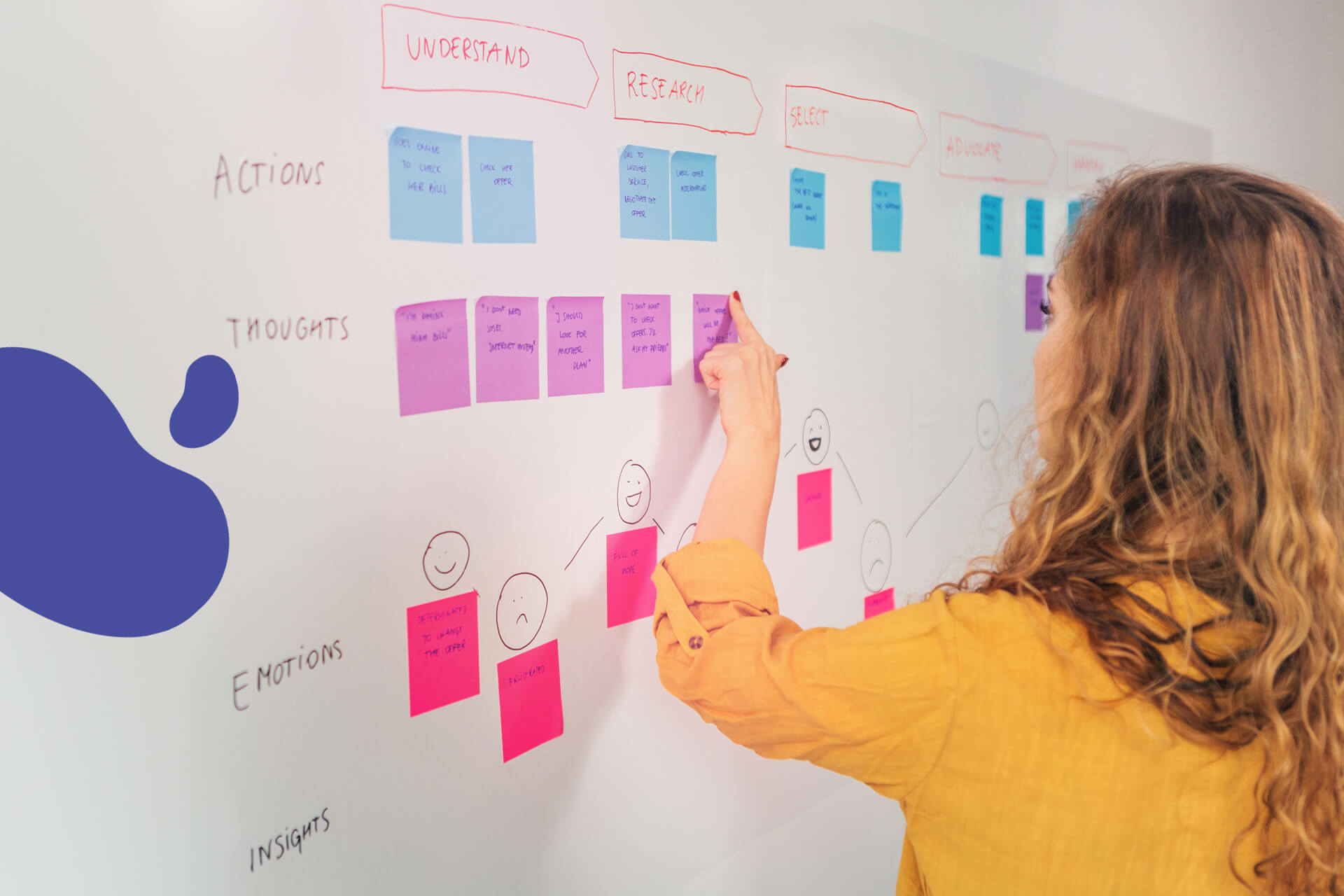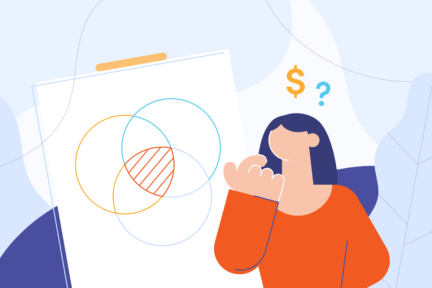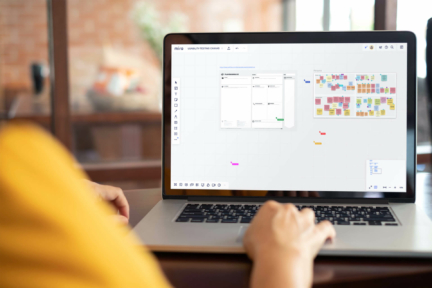Working as a product designer in a software development company is associated with many different challenges. The first one is to be versatile – after all, a product designer is not only the user’s advocate (just like UX designer), but also helps to achieve the client’s goals.
Creativity and analytical thinking are needed, as well as the ability to cooperate with many stakeholders at once – clients, project managers, analysts, testers and developers. Their work not only leads to the creation of an interface that pleases the eye but, above all, to the success of the entire product. This includes conceptual work, strategy and implementation, which is focused on delivering real business value, not just positive UX.
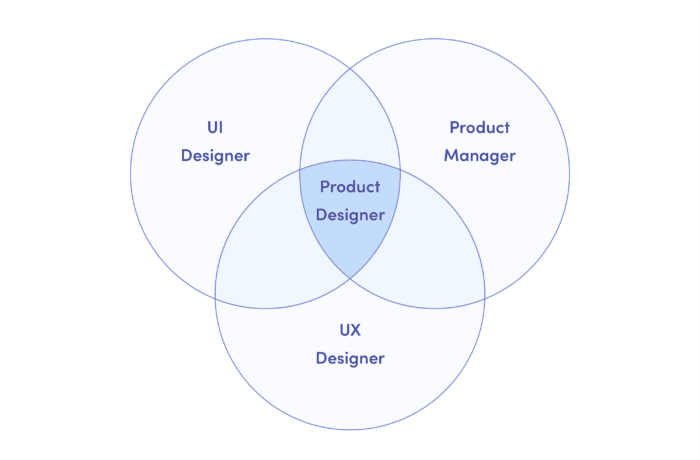
Therefore, whether you want to create a website, game or application, an efficient and properly executed product design process is key to the project’s success. Systematic and iterative work methodology allows the team to deliver products that are of the highest quality, have business potential, and are tailored to the needs of potential users.
Product design process is a useful tool for creating innovative and attractive business solutions, which helps to meet the growing expectations of customers and contributes to the success of enterprises.
But what exactly is the process of creating a product from A to Z?
What is the product design process?
The product design process is based on the popular Design Thinking methodology. According to its creator, Tim Brown, it is a human-centred approach to innovation that integrates the needs of people, the capabilities of technology, and the business requirements needed to achieve success.
Interestingly, this methodology is used not only when designing and creating digital products, but also in various physical services and products. One effective tool that allows users to describe Design Thinking as alternating cycles of divergent (expanding, exploratory) and convergent (narrowing, analytical) thinking is Double Diamond.
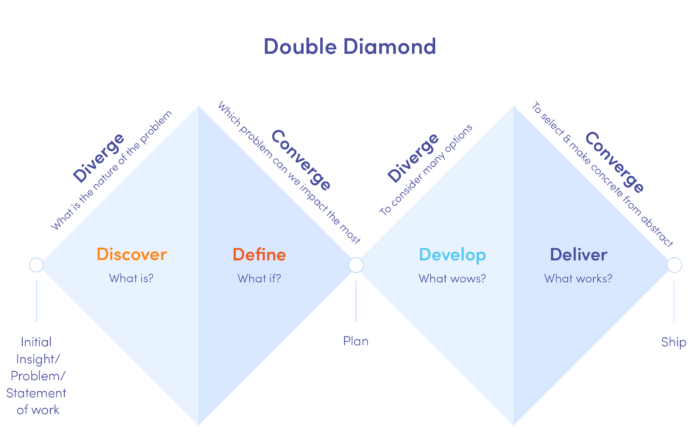
Double Diamond is a great tool that illustrates the design process, but you may feel that some steps are missing from it. Depending on how the individual sections of a Double Diamond are interpreted, the end result can be either a prototype or a ready-to-market product – two completely different things.
For this reason, at our product design company, we use the Triple Diamond scheme, which additionally includes the aspect of cooperation with development teams, without which it is difficult to imagine a product design process. It consists of several phases that structure the work on the project.
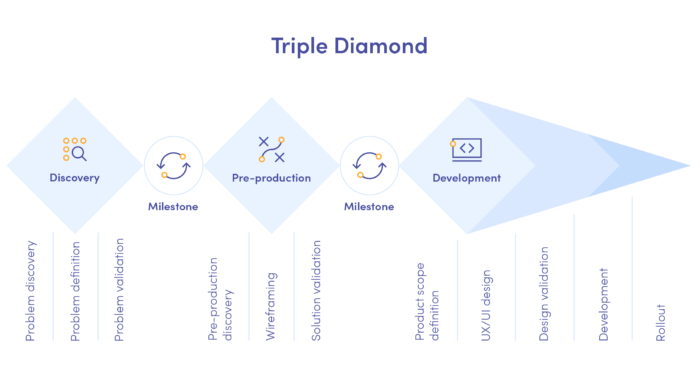
Triple Diamond is a flexible method, which means that it is tough to clearly define the exact framework of action based on this concept. The scope of work performed during the process depends on two major factors: the complexity of the identified problem and the work already done on the client’s side. But what does this really mean?
Imagine two different scenarios. The first, when the client has nothing but a general idea, and the second, when the client wants to plan new features or conduct the next development phase. This flexibility is an inherent part of the Triple Diamond method! In addition, Design Thinking is characterised by an interactive approach and non-linearity. Instead of going through each stage of the process, some of the phases may be repeated many times until satisfactory results are obtained.
Discovery
If you don’t have a clearly defined goal or problem to solve, you can expect two things – wasted time and inefficiency. The result of your design process may be solutions that do not match user needs. They can also lead to an incorrectly defined project scope or other unforeseen problems.
Although the client or team may feel that they know the answers to all questions and want to go straight to the implementation, it is important first to adjust and verify the assumptions we set for ourselves. That is why it is necessary to get into the customer’s shoes to understand their needs deeply and to recognise the hidden factors that affect human choices and behaviour. Therefore, well-conducted user research should be the foundation of the product design process.
Problem discovery
In the product design process, the discovery phase allows us to verify our assumptions, collect and analyse data, which helps us determine the purpose, potential and threats of a given project. Thanks to problem discovery, we can, among other things, determine and systematise customer requirements, analyse the needs of the target group or assess the market potential of the designed product.
The tools that are often used at this stage (depending on the type of project) are:
- UX audit: to review an existing digital product design process to ensure it meets business, UX, and accessibility requirements.
- Individual in-depth interview: to deeply understand the users and reach their needs, motivations and problems.
- Market research: to reveal the target audience and trends for a product or service.
- Protopersonas: to give an organisation a starting point to evaluate the product and create some early design hypotheses.
- Data analysis: to answer all the “how many” and “how often” questions.
- Service blueprint: to see the service delivery process from the customer’s perspective, and break down a project into manageable chunks and milestones.
- Survey: to collect user feedback and help you make sense of user behaviour.
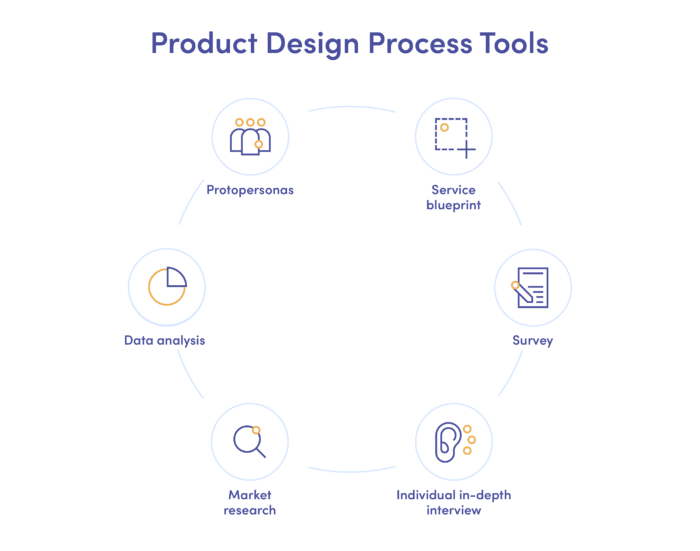
Explore even more UX research methods to learn all you need to know about the users!
Problem definition
In the problem definition phase, it is essential to analyse all the collected data and extract the most important information. The second product design process stage is the time to define the major needs and problems of users that your product will solve. Defining it is a crucial step, directly affecting the direction in which the team is going when designing the solution.
Some of the most important tools used during the problem definition phase are:
- Product vision: to describe the overarching long-term mission of the product.
- Value proposition: to focus the team’s attention on the development goal throughout the process (as a kind of visual aid).
- Problem statement: to accurately define a problem.
- Strategic research: to answer future-facing questions about users that help inform the long-term product direction and roadmap.
Problem validation
Once the problem is defined, it is important to validate it. We must verify if the idea needs to be modified and whether it fits the market. Choosing the wrong design challenge can lead to creating a product that does not suit user needs properly. For this purpose, conducting further studies may be useful, including focus groups, user interviews, surveys and observations.
If you validate your design challenge thoroughly, the chances for conquering the market skyrocket. Take our user-experience oriented car rental app which gained Skyscanner 1 mln new users in a relatively short time, or Dolby On app that reached 3.8 mln downloads shortly after launch. It all started with a refined product design plan.
If you need help with a UX Research Plan or persuading your client to do some research, check out our template in Figjam. It will let you plan and organise the research phase step by step!
Pre-production
The next step is the pre-production phase. During this product design process step, the team generates ideas for solving a predefined problem and creates the foundations for designing the UI of the application. Brainstorming is a good idea to unleash your imagination and generate as many ideas as possible without focusing on limitations. Despite its spontaneous character, brainstorming is an important step that allows us to work with stakeholders to develop an idea for a solution.
Apart from brainstorming, several different tools are equally and extremely useful during the pre-production phase:
- User journey mapping: to visualise all user interactions with our product and recreate the process he is experiencing.
- Personas: to understand who the user is, what motivations are behind his decisions and what kind of communication he expects. It allows the designer to focus on what is important from the users’ point of view.
- User scenarios: to define in what situations and for what purposes the users intend to use the product.
- Mind map: to help generate new ideas and identify relationships among different data and information.
Then, the design team creates a user flow, sketches a potential solution and builds a prototype based on the selected idea. It does not have to be exact. Most importantly, the prototype should allow usability testing of the concept to let users interact with the product. Prototypes enable us to test our idea’s validity and eliminate errors at an early stage of work. The results of such tests can help the team and stakeholders decide whether they want to continue the project.
Design and product development process
Based on the previous steps and the so-called “proof of concept”, we can continue working on the physical representation of our solution: flows, screens, and UI design. At the same time, we should remember that both users and stakeholders have verified our ideas. Therefore, we should correct the errors we caught while testing the prototype and learn from them.
The result of the design team’s work is the implementation of the solution and its introduction to the market by development teams. It involves a lot of collaboration between designers, the client, engineers and other implementation team members.
At Miquido, we often use a helpful method called User Story Mapping to build a product backlog. At this stage, we can also think about designing tests, like A/B tests, which will allow us to check the functioning of certain aspects of the product on the real market. We should constantly monitor metrics, compare them with previously established KPIs and, depending on the results, plan to redesign the product in such a way as to best suit the needs of users and meet business goals.
Summary
Let me summarise things briefly. Firstly, the product design process is not as complicated as it may seem. Going through each of the stages from the Design Thinking methodology allows us to:
- understand user desires
- address user needs
- generate new ideas
- design a useful (and profitable!) solution – ready for further tests or market implementation.
Secondly, it is always worth exploring various tools and checking what we feel best at and what is the easiest and most effective way to work for our team. No one ready solution works for all, and every company and designer has their favourite approaches and ways of working.
Last but not least, there is no doubt that the product design process framework facilitates both designer and client work. Whether creating a brand new product or developing additional functionalities, the design process saves product designers a lot of time and guarantees better product results.

